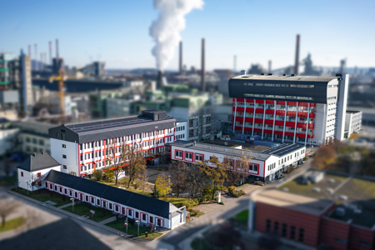Takeda's Award-Winning Facility Teaches You About Outsourcing

By Louis Garguilo, Chief Editor, Outsourced Pharma

The Takeda production site in Linz, Austria, received an ISPE’s 2024 Facility of The Year Award (FOYA) in the category of Operations.
What’s so special about that manufacturing location in Linz?
I asked Roland Fabris, Site Head, Takeda in Linz, Austria.
“Linz embarked on an exceptional venture, the beePFS project, a pioneering project in what Takeda calls its Super-Fast Track WARP Speed program.”

More directly, the ISPE award is for the prefilled syringe filling project undertaken in the manufacturing facility in Linz.
According to Takeda and ISPE, this upgrade project undertaken at the Linz manufacturing facility aimed to “revolutionize the process performance qualification (PPQ) timeline and enhance supply chain resilience through a strategic dual-source approach.”
This resulted in the facility becoming 50% faster at completing similar projects previously performed at Takeda, and within the entire industry.
(Notable, much of the upgrade took place during the COVID-19 pandemic and the challenges that brought on.)
I also spoke in detail to Fabris on whether internal facilities like his compete with external manufacturing options.
But before we get to that I’ll disclose to readers that this was a much-anticipated conversation for me.
Years ago, I worked directly with Takeda’s headquarters and its various facilities throughout Japan as a business development professional for a global CDMO.
Therefore, I greatly appreciate Fabris was such an open and thoughtful communicator. I’m sure readers will benefit from that as well.
That’s mainly because over two editorials, we’ll learn much about facility selection applicable to your own outsourcing needs.
Does Your CDMO Measure Up?
For those less familiar with Takeda, this organization has been operating for over 240 years.
I bring up that history to further accentuate the winning of an award in ISPE’s global contest centuries after formation also demonstrates an incredible longevity and centuries of innovation.
Today Takeda has programs targeting gastrointestinal and inflammation, rare diseases, plasma-derived therapies, oncology, neuroscience, and vaccines.
The award-winning manufacturing site in Linz, Austria began operations in the late 1960s as a small molecule production site, before expanding over the years and developing into a manufacturing hub for Takeda’s oncology and biologics products.
As I listened to Fabris explain how Linz worked through its current award-winning upgrade, it became apparent that most everything he mentioned could describe an optimal CDMO.
Fabris presented a benchmark against which you’ll want to evaluate the external facility you are contemplating for your development and manufacturing.
Advancing Acronyms
Fabris says unwinding the beePFS acronym takes some time. I’m happy to oblige.
“The beginning comes from beehive,” he says, which represents a kind of culture that has been established in Linz. This metaphor was in fact arrived at collectively at the Linz facility by the management and employees there.
“Actually, all this is based first on Japanese values and how an organization approaches working together, but we needed something locally to translate that. We came up with the beehive culture.”
First and foremost, Fabris takes us inside that bee-fabricated shell, “Everyone and everything done in a beehive works in service to the queen bee. We are patient-centric, working always with the patient in mind.”
Ahh … the old ‘queen bee as patient metaphor,’ I say to myself.
“All our employees coming to this site every morning should be reminded why they're here, and why what they're doing is so important,” he adds.
The metaphor also informs us, Fabris says, “that every person in the facility counts.”
“This is what we also want to live by. I'm not more important than anyone working on the line. All of us need to function to deliver products to patients.
“The final dimension,” he says, “is also very important to all Takeda, and that is the planet and environmental piece.”
“We want to achieve net zero greenhouse-gas-emissions in our value chain byfiscal year 2040 –. So, the beehive is a nice pseudonym for nature.”
I wonder: Who among our readers feels like the beehive metaphor fits their CDMO experience? Consider giving that some thought …
Changes In Direction
The ISPE Award announcement mentions “a revolutionizing of process performance qualifications.”
As mentioned above, Linz was a small-molecule production site formed in the 1960s, transformed into a hub for Takeda’s oncology and biologics products.
I mention to Fabris there are many CDMOs trying to make the change from small molecule to biologics, or newer technologies customers are pursuing today.
How do you make those transformations and convince customers to place their novel programs in your reformed facility?
“Most simply, you begin with performance” he replies, and by that he means customers will anticipate future success with a faith built upon prior outstanding performance.
“For us, it was the trust we built up inside Takeda over the years,” Fabris says, “That inspired the investments and resource allocations we needed to transform to fulfill the organization’s current needs.”
“We have always performed. We delivered productivity gains every year at 5% on average. We set a good track record with authorities. I think this is one of the utmost important things –always be able to deliver product for patients ultimately.”
With that track record comes customer trust, and new investment opportunities, whether that’s a internal site or a CDMO.
We should, then, be careful not overemphasis here-and-now “enhancement project” with their associated acronyms and defined completion dates.
The reality is the Lintz facility started its transformation over the better part of a decade, says Fabris, and he feels they are still “in the middle of transformation.”
Applying this to the evaluation of your CDMOs, a pertinent question is, “Have they remained relevant and reliable historically? Is their sudden “transformation project,” so to speak, actually a shock to their system?
Fabris is proud of the Award his facility has received as recognition of an important achievement.
But it also represents the past – a continuum of service – upon which the bright future is built.
------------
Chief Editor Louis Garguilo will continue his conversation with Roland Fabris, Site Head, Takeda in Linz, Austria, in part two.
